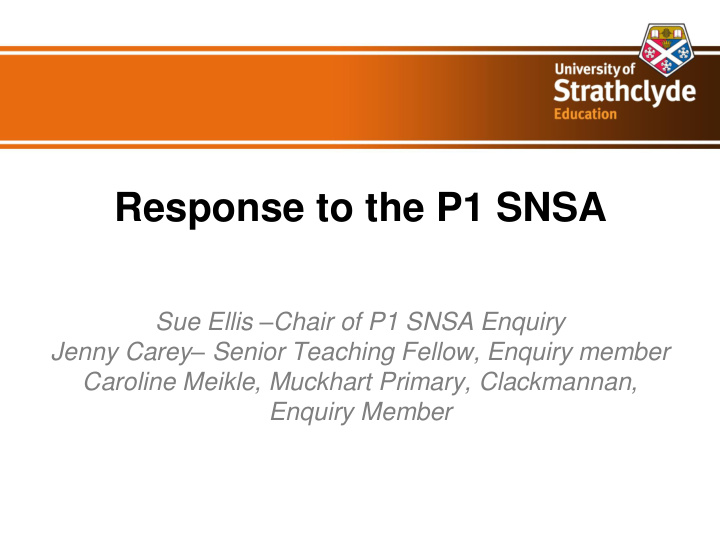



Response to the P1 SNSA Sue Ellis – Chair of P1 SNSA Enquiry Jenny Carey – Senior Teaching Fellow, Enquiry member Caroline Meikle, Muckhart Primary, Clackmannan, Enquiry Member
Aims & Process of the Enquiry • A Professional Forum to advise the Scottish Government, education policy and practitioner communities on the implementation and use of SNSA in Primary 1 classrooms. • Balanced membership – expertise in P1, management, local authority implementation and stance towards SNSA. • Open scrutiny – composition, agenda, meeting notes and presentations posted on Education Scotland website • Continuing – Reedy report recommendation • Seeking members – must have P1 experience
The perfect storm The perfect storm • Play – invisible pedagogy. Why are reading and • Play – invisible pedagogy. Why are reading and number positioned as work not play? number positioned as work not play? • Debate about when and how children are • Debate about when and how children are taught to read, write and count. taught to read, write and count. • Clash with phonics first and fast approaches – • Clash with phonics first and fast approaches – sounds, words and non-words in P1, sounds, words and non-words in P1, continuous text in P2. continuous text in P2. • SNSA expects children to read for meaning, • SNSA expects children to read for meaning, and to read meaningful sentences in P1. and to read meaningful sentences in P1.
PLAYFUL Caroline Meikle – TEACHING Muckhart Primary School, Clackmannanshire AND LEARNING
RESPONSE TO THE P1 SNSA Sue Ellis – Chair of P1 SNSA Enquiry Jenny Carey – Senior Teaching Fellow, Enquiry member Caroline Meikle, Muckhart Primary, Clackmannan, Enquiry Member
MUCKHART PRIMARY SCHOOL
Experiences and Outcomes MNU 0-02a I have explored numbers, understanding that they represent quantities, and I can use them to count, create sequences and describe order. MNU 0-03a I use practical materials and can ‘count on and back’ to help me understand addition and subtraction, recording my ideas and solutions in different ways.
Identify and recognise numbers.
Use one-one correspondence to count a given number of objects.
Identify “how many” in regular and irregular dot patterns.
Use mathematical language.
Count on and back to add and subtract.
Use mathematical symbols +, - and =.
Experiences and Outcomes LIT 0-01a / LIT 0-11a / LIT 0-20a I enjoy exploring and playing with the patterns and sounds of language, and can use what I learn. ENG 0-12a / LIT 0-13a / LIT 0-21a I explore sounds, letters and words, discovering how they work together, and I can use what I learn to help me as I read and write. LIT 0-09b / LIT 0-31a I enjoy exploring events and characters in stories and other texts and I use what I learn to invent my own, sharing these with others in imaginative ways.
Hearing and saying sounds, patterns and rhymes.
Participating in stories and rhymes.
Engaging with texts for enjoyment and sharing likes/dislikes .
Reading aloud.
Sequencing a story.
Creating new texts to share ideas and feelings.
Role Play Hot Seating Developing vocabulary Freeze Frame through story-based activities. Visualisation
How does the SNSA fit with this playful approach to learning?
Clackmannanshire Reading Project: in partnership with Strathclyde University The 3 Domain Model - focus used to be on the cognitive aspects of reading - Clacks working to shift to a more balanced model - Gains in children’s comprehension and confidence in reading already evident
Practical Outcomes • Report and recommendations • Playful Pedagogy in P1 does not preclude learning to read, write, count and think mathematically. • How can the SNSA fit with diagnostic, responsive teaching • Booklet by a sub-group – practitioners & researchers (Reading – generated most debate) • In draft • Considers underpinning skills & playful activities • Diagnostic – focus is on the right mix of activities
Booklet Structure • Introduction • Two sections: Comprehension & Orchestrating decoding • Troubleshooting – key questions (diagnostic) • Activities (Activity; Literacy learning; Nudge the learning; Take it up a notch). • Quick-fire activities (little explanation) • Diagnostic Overview – links activities to troubleshooting
Big question: How these ideas ‘land’ with teachers • Interested in all staff (not just high flyers) • Reading groups – what sense do they make of it • Teachers to try activities – what they noticed about children If you are interested in participating, leave email details. You will be asked which kind of trial you want & be sent a structured, confidential feedback form.
Recommend
More recommend